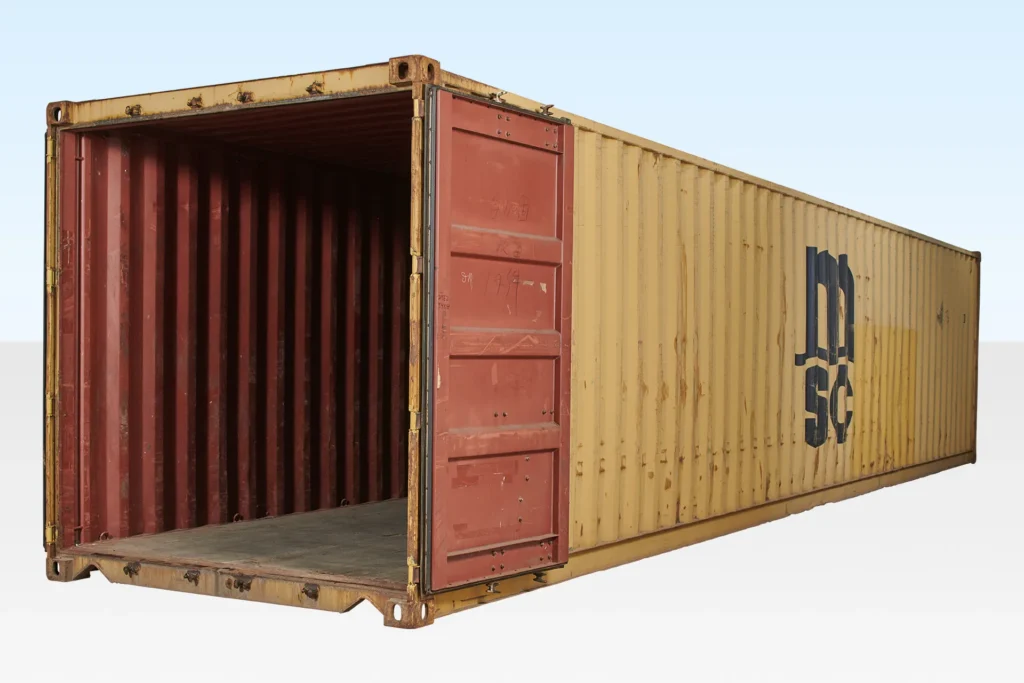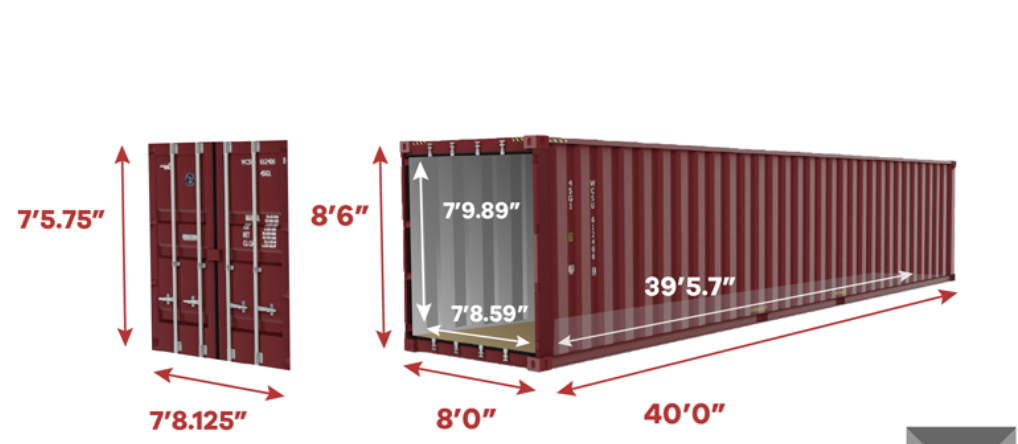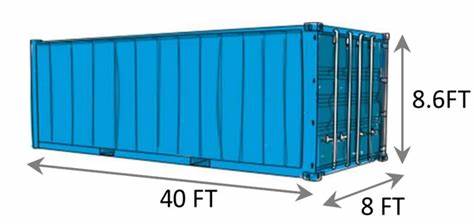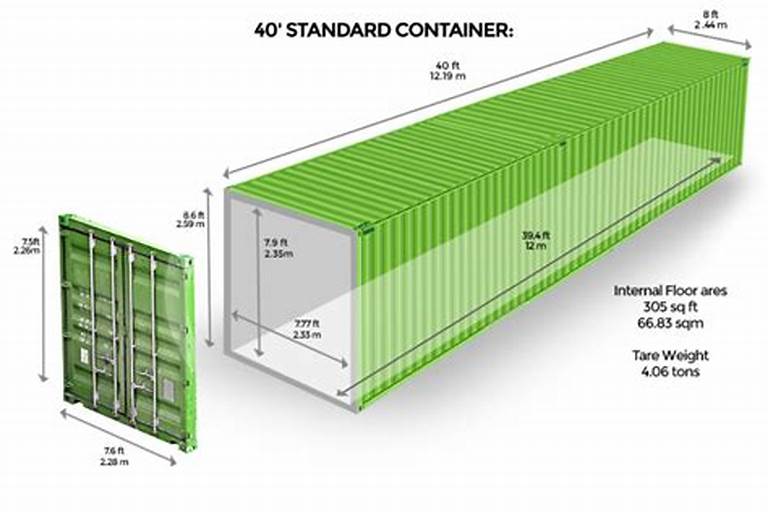40ft Shipping Containers: Dimensions, Uses, and Buying Guide
If you’ve ever wondered how goods get from overseas factories to your doorstep or considered building a home from steel boxes, you’re already thinking about the mighty 40ft shipping containers.
This behemoth of global logistics is one of the most essential tools in international trade and creative construction alike. Known for its strength, capacity, and versatility, the 40ft container is more than just a big metal box—it’s a mobile solution for storage, housing, transport, and even business.
Table of Contents
In this detailed guide, we’ll explore everything you need to know about 40ft shipping containers—from technical specifications to real-world applications—so you can decide if it’s the right choice for your next project or purchase.
What is a 40ft Shipping Container?

A 40ft shipping container is a large, standardized steel unit used globally to transport goods over sea, land, and rail. These containers are ISO-certified, which means they meet strict international standards for safety, durability, and compatibility with cranes, ships, and trucks.
Typical Uses:
- Transport of goods across continents
- Storage of equipment, tools, or bulk items
- Base for mobile or modular structures like homes and offices
Key Features:
- Wind and water-resistant
- Lockable and secure
- Made from Corten steel for long-term durability
- Easily stackable and portable
From massive cargo ships to construction sites and pop-up shops, the 40ft container plays a key role in both industrial and everyday applications.
40ft Shipping Container Dimensions and Specifications
Understanding the precise dimensions of a 40ft container is essential for planning logistics, storage, or modifications. Here’s a breakdown of both standard and high cube models.
Standard 40ft Container:
| Specification | Measurement |
|---|---|
| External Length | 40 ft (12.19 m) |
| External Width | 8 ft (2.44 m) |
| External Height | 8.6 ft (2.59 m) |
| Internal Length | 39.5 ft (12.03 m) |
| Internal Width | 7.7 ft (2.35 m) |
| Internal Height | 7.9 ft (2.39 m) |
| Volume Capacity | ~2,390 cubic ft (67.7 m³) |
| Tare Weight | ~8,380 lbs (3,800 kg) |
| Max Payload | ~59,000 lbs (26,760 kg) |
High Cube 40ft Container (for extra height):
| Specification | Measurement |
|---|---|
| External Height | 9.6 ft (2.9 m) |
| Internal Height | 8.9 ft (2.7 m) |
| Volume Capacity | ~2,694 cubic ft (76.3 m³) |
The high cube version is ideal for taller cargo or for building modifications where headroom matters.
Types of 40ft Shipping Containers
Not all 40ft containers are created equal. Depending on your specific needs, you can choose from several types:
- Standard Dry Container:
- For general cargo
- Most commonly used type
- High Cube Container:
- Offers an extra foot of height
- Popular in modular construction
- Refrigerated (Reefer) Container:
- Temperature-controlled
- Ideal for perishable goods like food or medicine
- Open Top Container:
- Allows overhead loading
- Great for tall or awkwardly shaped cargo
- Flat Rack Container:
- No sides or roof
- Used for oversized items like machinery or vehicles
Each type is engineered for specific functions, making the 40ft container a highly versatile asset across industries.
Common Uses of 40ft Shipping Containers

From global logistics to off-grid living, the 40ft shipping container serves a wide variety of purposes beyond freight shipping. Here are some of the most common:
1. Global Freight:
- Transporting goods internationally
- Essential for import/export businesses
2. On-Site Storage:
- Tool and equipment storage on construction sites
- Seasonal storage for retailers or event organizers
3. Modular Construction:
- Container homes, cafes, and offices
- Used in disaster relief housing and eco-villages
4. Agriculture:
- Seed and feed storage
- Hydroponic farms and mobile greenhouses
5. Pop-Up Businesses:
- Mobile shops, studios, or food stalls
- Easily branded and relocated
6. Emergency Response:
- Used as temporary shelters or field hospitals
- Rapid deployment in disaster zones
Thanks to its capacity and build quality, the 40ft container is increasingly found in places where traditional construction can’t keep up.
Advantages of Using a 40ft Shipping Container
The 40ft shipping container offers several compelling advantages, making it a popular choice across industries. Whether you’re shipping cargo or setting up a container home, its design and features offer superior value.
1. Massive Storage Capacity
- With nearly 2,400 cubic feet of usable space, a 40ft container can hold the contents of a standard 3-bedroom house.
- Ideal for bulk storage or large-scale shipments.
2. Cost-Effective Logistics
- More space per dollar compared to smaller containers.
- Lower shipping costs per cubic foot when fully utilized.
3. Durability and Security
- Built with corrosion-resistant steel to withstand harsh environments.
- Can be securely locked, reducing the risk of theft or tampering.
4. Modular and Stackable
- Standardized design allows easy stacking and modular builds.
- Used in everything from multilevel offices to apartment complexes.
5. Long-Term Investment
- Lifespan of 20+ years with proper care.
- Can be resold or repurposed, preserving value over time.
6. Eco-Friendly Potential
- Upcycling into homes or offices reduces waste.
- Strong sustainability appeal for green-conscious projects.
Whether you’re thinking globally or locally, a 40ft container can deliver both efficiency and versatility in one steel package.
20ft vs 40ft Shipping Containers
If you’re torn between container sizes, understanding the key differences can help you make the right choice for your needs.
| Feature | 20ft Container | 40ft Container |
|---|---|---|
| Internal Volume | ~1,170 cu ft | ~2,390 cu ft |
| External Length | 20 ft | 40 ft |
| Max Payload | ~62,350 lbs | ~59,000 lbs |
| Common Uses | Dense, heavy items | Large or voluminous goods |
| Cost | Lower | Higher upfront, better cost-per-cubic-foot |
Key Takeaways:
- 20ft containers are ideal for heavier cargo where weight is a concern.
- 40ft containers are best for lighter but bulkier goods, or when volume efficiency is key.
In construction or storage applications, 40ft containers offer better scalability, especially when building or modifying.
New vs Used 40ft Shipping Containers
Should you buy a brand-new container or save money with a used one? The answer depends on your project and budget.
New (One-Trip) Containers:
- Used once to transport goods, usually from Asia to the U.S. or Europe.
- Virtually no wear or damage.
- Cost: $5,000 – $7,000+
Used Containers:
- Have been in circulation for years.
- May have cosmetic wear or minor rust, but still structurally sound.
- Cost: $2,500 – $4,500
Pros of New Containers:
- Clean and ready for custom modifications.
- Longer lifespan.
- Often include warranty.
Pros of Used Containers:
- Lower upfront cost.
- Eco-friendly (reuse instead of building new).
Inspection Checklist for Used Containers:
- Check for floor damage, rust spots, and door function.
- Smell inside for mold, chemicals, or contamination.
- Confirm watertight seals.
When buying for shipping or resale, new is often worth the investment. For storage or conversion, used containers can offer excellent value.
Cost of 40ft Shipping Containers
The price of a 40ft shipping container can vary widely based on condition, location, and market demand. Here’s a breakdown to help you budget.
Typical Pricing:
| Condition | Price Range |
|---|---|
| New (One-Trip) | $5,000 – $7,000 |
| Used (Cargo Worthy) | $3,000 – $4,500 |
| Rental (Monthly) | $100 – $250 |
Cost Influencers:
- Location: Containers cost more in inland or remote areas.
- Demand: Prices can spike during global shipping disruptions.
- Condition: Cosmetic vs structural issues impact pricing.
- Delivery: Fees can add $500–$1,500 depending on distance.
Money-Saving Tips:
- Buy in off-peak seasons.
- Compare multiple vendors.
- Consider buying from port cities for lower transport costs.
Be sure to factor in hidden costs like delivery, modifications, and permits to avoid surprises.
Where and How to Buy a 40ft Shipping Container
Buying a container is easier than ever, but it’s important to choose a reputable vendor and follow the right steps.
Top Places to Buy:
- Local Dealers: Often offer inspection before purchase.
- Online Marketplaces: ContainerAuction, Craigslist, eBay.
- Specialized Suppliers: Conexwest, SeaBox, Triton.
Step-by-Step Buying Guide:
- Determine Your Needs: Storage, shipping, or modification?
- Set a Budget: Include delivery and modifications.
- Get Quotes: Always ask about condition, delivery fees, and lead time.
- Inspect the Container: Physically if local, or request photos and specs.
- Negotiate and Confirm: Ensure terms, warranty, and return policy are clear.
- Schedule Delivery: Prep your site and confirm drop-off logistics.
Choosing the right vendor can save you money and headaches, so take your time researching before committing.
Renting a 40ft Shipping Container
If purchasing a container feels like a large commitment, renting a 40ft shipping container can be a flexible and cost-effective alternative—especially for short-term projects or seasonal needs.
Who Should Consider Renting?
- Construction companies needing temporary on-site storage
- Event organizers requiring secure equipment housing
- Retailers managing seasonal inventory overflow
- Individuals in transition (moving, renovation, etc.)
Pros of Renting:
- No long-term commitment
- Maintenance often included
- Quick delivery and pick-up
- Ideal for short-term needs or testing before buying
Cons of Renting:
- No equity or resale value
- Limited customization options
- Higher long-term cost vs. buying
Typical Rental Costs:
| Container Type | Monthly Rent (USD) |
|---|---|
| Standard 40ft | $100 – $200 |
| High Cube 40ft | $120 – $250 |
| Refrigerated | $300 – $600 |
Rental Tips:
- Read the rental agreement carefully (especially damage and delivery clauses).
- Inspect the unit on arrival—take photos of any dents, rust, or damage.
- Clarify who covers maintenance and repairs during the rental period.
Renting gives you flexibility and convenience without the upfront cost, making it a smart option for many use cases.
Modification Ideas for 40ft Shipping Containers
One of the most exciting aspects of the 40ft shipping container is its adaptability. With the right planning, these containers can be transformed into functional and even luxurious spaces.
Top Modification Ideas:
- Container Homes
- Modern, minimalist designs
- Full kitchens, bathrooms, and insulation
- Great for off-grid living or ADUs
- Office Spaces
- On-site field offices
- Co-working hubs
- Remote work cabins
- Retail Shops
- Pop-up cafes, fashion boutiques
- Easily branded and mobile
- Cost-effective alternative to brick-and-mortar
- Workshops and Studios
- Secure tool and equipment storage
- Music or art studios
- Mechanics garages
- Emergency Shelters
- Disaster response housing
- Rapid deployment field clinics
Popular Add-Ons:
- Windows and glass doors
- Plumbing and electrical systems
- Insulation and climate control
- Solar panels and green roofs
Modification Costs:
- Basic retrofit: $5,000 – $10,000
- Full conversion (home/office): $15,000 – $30,000+
- Luxury or off-grid options: $40,000 and up
Pro Tip: Always work with professionals who understand structural integrity and local building codes. Poor modifications can compromise safety and durability.
Delivery and Transport of 40ft Shipping Containers
Transporting a 40ft shipping container requires careful planning. These massive units need specialized equipment and space for safe delivery.
Delivery Options:
- Tilt-Bed Truck (Roll-Off):
- Easy for short-range delivery
- Driver tilts bed to slide container onto the ground
- Flatbed Truck with Crane:
- Necessary if container must be lifted off
- Ideal for inaccessible or tight locations
- Chassis Delivery:
- Common for port pickups
- Requires site equipment to offload
Site Preparation:
- Ensure level ground (gravel or concrete pad preferred)
- Clear space: At least 100 ft in length and 12 ft in width
- Check overhead clearance (min. 14 ft)
- Mark placement with cones or chalk
Delivery Costs:
- Local (within 50 miles): $500 – $800
- Regional (50–200 miles): $800 – $1,500
- Long-haul: Depends on mileage and fuel surcharges
Tips for Smooth Delivery:
- Be on-site during delivery to supervise
- Ensure access for large trucks and turning radius
- Plan for weather—muddy or icy ground can delay setup
Proper prep ensures safe, efficient placement and avoids costly rescheduling fees.
Legal Considerations and Zoning Rules
Before placing or modifying a 40ft shipping container on your property, it’s essential to understand local laws and regulations.
Key Legal Considerations:
- Zoning Laws:
- Residential areas may restrict or limit container use
- Commercial or industrial zones are usually more lenient
- Building Permits:
- Required for permanent installations or modifications
- Often needed for plumbing, electrical, or multi-container builds
- HOA Restrictions:
- Some neighborhoods ban containers entirely
- Others require them to be hidden or temporary
- Utility Hookups:
- Adding electricity or plumbing may trigger inspections
How to Stay Compliant:
- Contact your city or county planning department
- Describe your project clearly (storage vs. living space)
- Apply for necessary permits before starting work
- Work with licensed contractors for installations
Common Violations:
- Placing a container without a permit
- Stacking containers in residential zones
- Ignoring setback and height requirements
Following the rules protects your investment and prevents fines or removal orders.
Sustainability and Eco-Friendly Use
The 40ft shipping container isn’t just a tool for transport and construction—it’s a symbol of sustainability when used thoughtfully. Repurposing containers has become a popular movement in the green building space, contributing to eco-friendly solutions worldwide.
Why 40ft Containers Are Sustainable:
- Recycling Industrial Waste
- Repurposing containers reduces the need for new building materials.
- Millions of decommissioned containers are available, reducing steel waste.
- Energy Efficiency
- When properly insulated, container homes and offices are energy-efficient.
- Smaller spaces require less heating and cooling, cutting utility usage.
- Reduced Construction Impact
- Container buildings cause less disruption to land compared to traditional construction.
- Prefab modifications reduce site waste and labor energy.
- Mobility and Reuse
- Can be relocated and reused for different purposes.
- No need to demolish or rebuild—a flexible, long-lasting solution.
Eco-Friendly Project Ideas:
- Off-grid solar-powered homes
- Mobile clinics and schools for underserved regions
- Hydroponic farming systems inside containers
- Recycling centers and compost stations
Sustainability Tips:
- Use non-toxic paints and coatings.
- Opt for natural or recycled insulation (sheep’s wool, denim).
- Incorporate solar panels, LED lighting, and water-saving fixtures.
When paired with smart design, a 40ft container can be the foundation for a greener, more resource-efficient future.
Maintenance and Care Tips

Even the toughest 40ft shipping container needs occasional TLC to stay in top condition. Whether you’re using it for storage or living, regular maintenance will maximize its lifespan and performance.
Regular Maintenance Checklist:
- Inspect for Rust:
- Focus on door hinges, roof edges, and floor corners.
- Sand, prime, and repaint rust spots promptly.
- Check Door Seals and Locks:
- Ensure watertight gaskets are intact.
- Lubricate hinges and lock rods twice a year.
- Clean the Roof and Gutters:
- Remove debris and standing water.
- Prevent water pooling which leads to corrosion.
- Maintain Interior Conditions:
- Use moisture absorbers or vents to prevent condensation.
- Regularly inspect for mold, pests, or chemical residue.
- Inspect the Floor:
- Most container floors are marine-grade plywood.
- Watch for rot, warping, or oil/chemical damage.
- Repaint Every 5–10 Years:
- Use marine-grade or anti-rust paint for exterior touch-ups.
- A fresh coat extends life and improves appearance.
Storage Tips:
- Elevate container on concrete pads or blocks to prevent ground contact.
- Place away from overhanging trees or flood zones.
- Install a security system for valuable contents.
With consistent care, your 40ft container can serve reliably for 25 years or more.
Conclusion
The 40ft shipping container is more than a storage solution or shipping tool—it’s a modern building block for creativity, sustainability, and efficiency. With its massive capacity, sturdy build, and endless flexibility, this container type continues to prove its worth across industries.
Whether you’re a logistics manager, real estate developer, entrepreneur, or homeowner, understanding how to utilize a 40ft container opens up a world of opportunity. From affordable housing and mobile businesses to emergency relief and eco-living, it’s a smart investment that pays dividends in functionality and long-term value.
Ready to buy, rent, or build with a 40ft shipping container? Explore your options, talk to local suppliers, and bring your vision to life.
FAQs About a 40ft shipping container
1. How much fits in a 40ft shipping container?
A 40ft container holds about 2,390 cubic feet, or roughly the contents of a 3-4 bedroom home. It can carry up to 59,000 lbs of cargo.
2. Can a 40ft container be used for housing?
Absolutely. Many homes are built from one or multiple 40ft containers. They offer fast, eco-friendly, and affordable housing solutions.
3. How much does a 40ft container cost?
New containers range from $5,000 to $7,000+, while used options cost around $3,000–$4,500. Rentals run $100–$250 per month.
4. How tall is a 40ft high cube container?
A high cube container is 9.6 feet tall externally and about 8.9 feet inside—one foot taller than the standard 8.6 ft container.
5. Is it better to rent or buy a 40ft container?
Rent if you need a short-term solution. Buy if your use exceeds one year or involves customization, resale, or long-term storage.







